How to Track ROI in Digital Marketing Campaigns

In today's highly competitive online landscape, Digital Marketing ROI is more than only one buzzword. This is an important indicator that helps businesses determine the effectiveness of their marketing efforts. Brand search engines invest important resources in advertising, payment advertisements, social media, email marketing, and content strategies, but without a clear understanding of returns on investment, it is almost impossible to scale or refine them efficiently. Whether you test a small business, a large brand that optimizes new channels, or mature expeditions, it is necessary to ensure that each marketing dollar is producing real business results.
Understanding the Importance of ROI in Digital Marketing
The return on ROI, or investment, reflects the revenue obtained compared to the money spent. In terms of digital marketing, the ROI explains how much your marketing campaigns are taking advantage of the investment made in them. While traditional marketing was difficult to measure with accuracy, digital platforms have made it possible to track user interactions, clicks, conversions, and other data points in real time.
Understanding this data not only indicates budget allocation but also states which marketing channels are the most efficient. A campaign that generates thousands of impressions, but no conversions, can ruin valuable resources, while a small, highly targeted advertising expense with high conversion can significantly increase the profit. Knowing what works and what does not helps to streamline strategies for greater impact.
Setting Up Goals and KPIs
Before tracking ROI, businesses need to define what success looks like.
Clear goals and the foundation of KPI (major performance indicators) are the foundation of any successful campaign. For example, if your goal is to increase sales online, your KPI cost may be perfect (CPA). If the focus is on lead generation, the cost per lead becomes more relevant.
With each campaign, define what a valuable action is. Whether it is a product purchase, a webinar signup, or a phone inquiry, these targets direct the entire marketing strategy and are essential for tracking returns. It is equally important to distinguish between vanity metrics, such as likes and shares, and result-focused metrics such as revenue, conversion, or lead-centered metrics.
Choosing the Right Attribution Model
ROI is one of the most complex parts of analysis. Digital users often interact with several touchpoints before converting, such as clicking a Facebook advertisement, reading a blog post, and finally buying through an email link. Choosing the right attribution model helps you understand which parts of your strategy are contributing to conversions.
Some common attribution models include:
- First-touch: Attributes 100% of the credit to the first interaction.
- Last-touch: Gives full credit to the final interaction before the conversion.
- Linear: Distributes credit equally across all touchpoints.
- Time decay: Gives more credit to touchpoints that occur closer to the conversion
Depending on your business type and customer travel complexity, the right model will be different. Tools such as Google Analytics 4 allow custom attribution models, which give you flexibility on how to calculate the RO the I's funnel.

Tracking Tools and Platforms
Analytics greatly rely on the platforms to track the performance of modern digital abusive campaigns. Google Analytics, Facebook Ads Manager, Hubspot, nd other CRM tools allow you to monitor important data such as traffic sources, bounce, conversion rates, and customer behavior in man touch touchpoints.
The UTM parameter is an important component of tracking specific campaigns. By tagging the URL with the custom UTM code, the marketers can identify which ad or content group leads to one click or conversion. In the performance of the campaign, this granular insight makes it easier to double the high-performing strategy and quickly cut the deficit of the underperforming initiative.
For e-commerce businesses, integrating your website with platforms such as Shopify or WooCommerce provides even deeper insight. You can track the entire customer life cycle, from advertising clicks to final purchase, all in a centralized dashboard. Similarly, for service-based businesses, CRMs such as Salesforce or Zoho can be integrated with marketing platforms to track leads, calls, and deals via a funnel.
Calculating ROI: The Formula
The basic formula for ROI is:
(Revenue – Cost of Investment) ÷ Cost of Investment x 100
For example, if you spend $2,000 on a campaign and generate $5,000 in sales, your ROI would be:
($5,000 – $2,000) ÷ $2,000 x 100 = 150% ROI
However, this simple formula cannot reflect the complete complexity of digital marketing. A customer's lifetime value (LTV), such as ideas, retention rates, or even branding benefits, can affect the actual ROI. A customer acquired through Facebook advertising can initially generate only $ 100 in revenue, but if he buys or refers others, their long-term value may exceed the early returns.
Interpreting ROI Correctly
Not all campaigns need to show immediate financial returns. Some strategies, such as content marketing or SEO, are long-term investments. They cannot generate revenue immediately, but can manufacture awareness and organic traffic over time. It is necessary to separate direct ROI from strategic ROI. Brand visibility, better trust, and domain authority may not be tangible in the short term, but hold long-term value.
Tracking ROI is not only about what is working, but also about learning, refining, and developing. An expedition may seem heavy in the beginning, but with small tweaks, it improves with targeting, creativity, or landing page design. Constant tracking and analysis allow businesses to make data-supported decisions rather than working on estimates.
AI and automation role in ROI tracking
With the increasing complexity of digital marketing data, AI and machine learning have become powerful tools in analyzing performance and predicting ROI. These technologies can identify patterns that are difficult to detect manually, such as user behavior that correlates with high conversion possibilities or campaigns that perform better at a fixed time of the day.
AI-operated platforms such as Adobe Sensei, Google's smart dialect, or the predictive lead scoring of Hubspot are changing how the markets adapt and score their campaigns. By automating reporting and insight, teams can focus more on creative strategy and reduce manual number crunching. Since more businesses adopt AI tools, ROI tracking will become sharper, cleverer, and more accurate.

Continuous Optimization for Better ROI
ROI tracking is not a one-time job-it is a continuous process. Changes in market trends, consumer behavior, and algorithms mean that tomorrow's victory strategy cannot work tomorrow. Continuous A/B tests, heatmap, user survey, and performance analysis help to refine your attitude.
Marketing teams should regularly meet regular assessment of what is working, what improvement is required, and where new opportunities are. This tight approach ensures that ROI is constantly improving, the budget is being maximized, and every channel is being used to its full capacity.
Conclusion: Why ROI Tracking Matters for Your Digital Growth
Ultimately, tracking ROI in digital marketing is about accountability, clarity, and intelligent decision making. Businesses that monitor their performance in detail are more likely to succeed in their campaigns, adapt to market change, and maximize profit in every channel. ROI tells the story of your marketing - from the first click to the final conversion - and helps you to prove the value of your efforts.
Agencies such as STS Digital Solutions are experts in creating a highly effective digital marketing strategy that not only reaches your target audience, but also average ROI.
Whether you're just starting with paid campaigns or optimizing a mature SEO pipeline, professional insight, and proper tracking can turn your marketing efforts into a consistent revenue engine.


